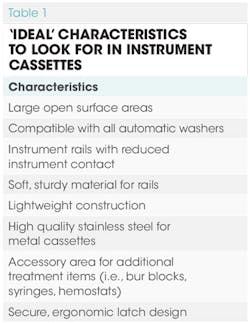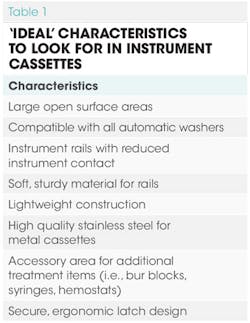How cassettes evolved: To understand the future of infection control, know how far we've come
To understand the future of infection control, know how far we've come
BY John A. Molinari, PhD
A mentor of mine gave me very useful advice when I was just beginning my academic career. It was this: "You need to understand where you have been in order to appreciate where you are now, which allows you to realize how far there is to go." Many years later, I still remember lessons in that message and remain appreciative of my friend's interest.
While those words were offered in a different context, they can also apply to the ongoing evolution of infection control in dentistry. Imagine a dentist, dental hygienist, and dental assistant practicing acceptable infection prevention in the early 1970s. (More than a few of you don't even need to imagine; you remember.)
-----------------------------------------------
Other articles by Molinari
- Instrument cassettes: Thinking ahead
- Face masks: Selection criteria and choices
- Instrument processing and recirculation: issues and considerations
-----------------------------------------------
Suddenly, they enter a time warp together and find themselves standing in a modern, twenty-first century dental facility. Even with their level of training for infection control in their era, they would probably be amazed at what is currently in place:
- OSHA and bloodborne pathogens manuals
- Suggested infection control checklists
- Programmable heat sterilizers
- Spore testing
- Disinfectant wipes instead of liquid spray bottles
- Routine use of gloves, masks, and eyewear during patient care
- Water in separate bottles used during treatment
- Hand hygiene procedures using combinations of water and waterless products, among other advances
Our time travelers might also notice that instruments used for patient treatment were packaged in closed metal, plastic, or resin containers instead of paper pouches. While patient instruments in such containers would be a new concept to them, cassettes had already been introduced years earlier in hospitals to organize instrument sets for surgical procedures.
What our trio would not be aware of was that cassettes for dental instruments were introduced into clinical practice in the 1980s, with military clinics being major users. Since then, this technology has expanded rapidly and is now found in the overwhelming majority of North American dental teaching facilities and many practices. Generations of cassettes have served as important components of an effective infection control program by streamlining instrument reprocessing and minimizing risks for personnel occupational exposures.
However, true to the advice of my mentor, appreciating current benefits should foster further efforts for research and development to advance and improve cassette technology.
For example, an occasional question from users concerns the relationship of the cassette and the cleaning efficacy of the instruments inside. Most available cassettes feature a patterned open area on the top and bottom of the cassettes in order to allow for ultrasonic or instrument washer cleaning. However, in some instances, if accumulated, dried debris is not rinsed off prior to automated cleaning procedures, residual material could be occasionally found on hard-to-reach instrument surfaces or on cassette rails prior to heat sterilization. It is important to have as much open area to the instruments as possible. Increasing the size of these access portals should allow enhanced cleaning and rinsing with automated cleaning equipment. This design could also reduce the potential accumulation of small amounts of water that can collect in the corners of cassettes loaded on the narrow end.
In addition, a well-designed cassette rail system is of significant importance to the overall cleaning efficacy of the instruments. It is important to have a rail system that will hold the instruments securely in place, rather than loose in the cassette, causing instrument damage. At the same time, the rails should have minimal contact with the instruments, allowing the detergent and water optimal access to the instrument surfaces.
Cassette latches that may stick and become difficult to open or close provide another evolution opportunity. A latch that could be easily opened and shut, and clearly indicates whether the cassette is locked or unlocked, could help prevent instruments from spilling out during handling. This adds an additional safety factor. Table 1 presents a representative list of desirable features that can address these and other potential issues.
In summary, as part of your practice's future, consider the inclusion of cassettes into your infection prevention program. Think first about what "ideal" design and functional characteristics you would like a dental cassette to exhibit. The bottom line is you can find products that meet both infection control criteria and your needs. RDH
JOHN A. MOLINARI, PhD, is director of infection control for The Dental Advisor. Previously, he served for 32 years at the University of Detroit Mercy School of Dentistry as professor and director of infection control. He has published numerous scientific articles, text chapters, and abstracts in microbiology/immunology, and lectures nationally and internationally on topics dealing with infectious diseases and infection control. He serves as a consultant for the ADA and regional hospitals.

